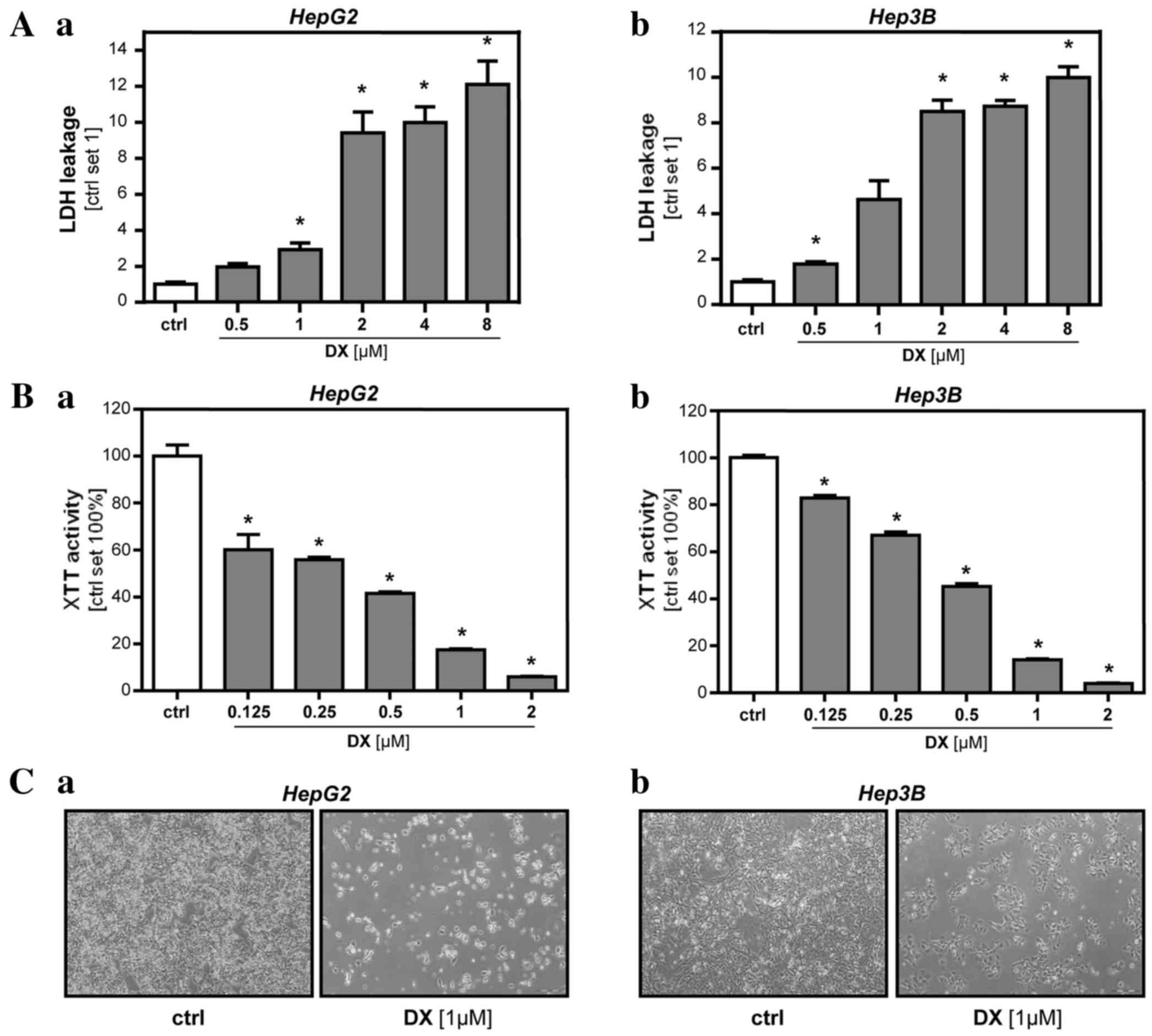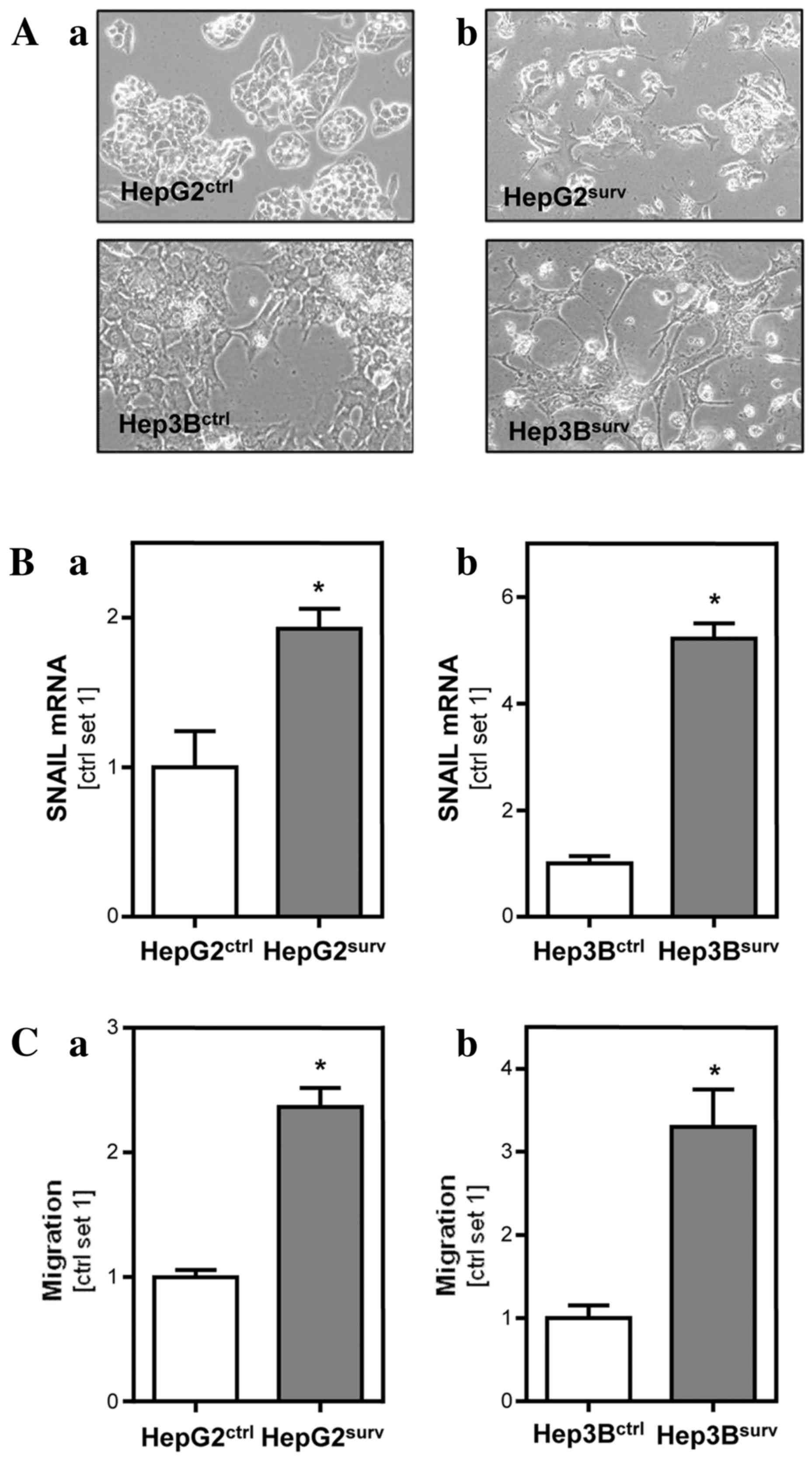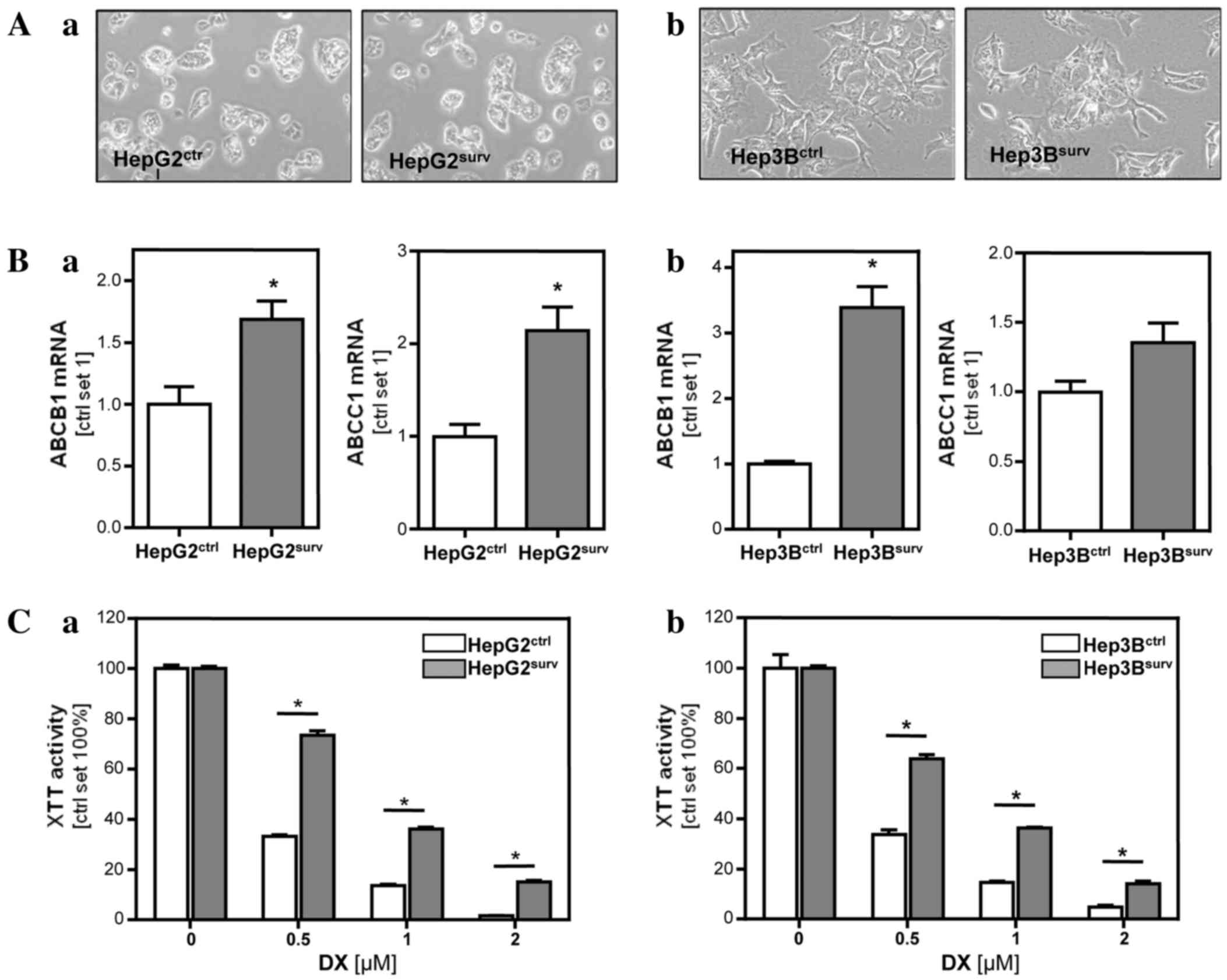|
1
|
Lin S, Hoffmann K and Schemmer P:
Treatment of hepatocellular carcinoma: A systematic review. Liver
Cancer. 1:144–158. 2012. View Article : Google Scholar : PubMed/NCBI
|
|
2
|
Mazzanti R, Arena U and Tassi R:
Hepatocellular carcinoma: Where are we? World J Exp Med. 6:21–36.
2016. View Article : Google Scholar : PubMed/NCBI
|
|
3
|
Bruix J, Boix L, Sala M and Llovet JM:
Focus on hepatocellular carcinoma. Cancer Cell. 5:215–219. 2004.
View Article : Google Scholar : PubMed/NCBI
|
|
4
|
Hernandez-Gea V, Toffanin S, Friedman SL
and Llovet JM: Role of the microenvironment in the pathogenesis and
treatment of hepatocellular carcinoma. Gastroenterology.
144:512–527. 2013. View Article : Google Scholar : PubMed/NCBI
|
|
5
|
Belghiti J: Treatment of hepatocellular
carcinoma. Bull Acad Natl Med. 196:97–103. 2012.PubMed/NCBI
|
|
6
|
Biolato M, Marrone G, Racco S, Di Stasi C,
Miele L, Gasbarrini G, Landolfi R and Grieco A: Transarterial
chemoembolization (TACE) for unresectable HCC: A new life begins?
Eur Rev Med Pharmacol Sci. 14:356–362. 2010.PubMed/NCBI
|
|
7
|
Xiao EH, Guo D and Bian DJ: Effect of
preoperative transcatheter arterial chemoembolization on
angiogenesis of hepatocellular carcinoma cells. World J
Gastroenterol. 15:4582–4586. 2009. View Article : Google Scholar : PubMed/NCBI
|
|
8
|
Park W, Chung YH, Kim JA, Jin YJ, Lee D,
Shim JH, Lee D, Kim KM, Lim YS, Lee HC, et al: Recurrences of
hepatocellular carcinoma following complete remission by
transarterial chemoembolization or radiofrequency therapy: Focused
on the recurrence patterns. Hepatol Res. 43:1304–1312. 2013.
View Article : Google Scholar : PubMed/NCBI
|
|
9
|
Niessen C, Wiggermann P, Velandia C,
Stroszczynski C and Pereira PL: Transarterial
chemoembolization-status quo in Germany. Rofo. 185:1089–1094. 2013.
View Article : Google Scholar : PubMed/NCBI
|
|
10
|
Thorn CF, Oshiro C, Marsh S,
Hernandez-Boussard T, McLeod H, Klein TE and Altman RB: Doxorubicin
pathways: Pharmacodynamics and adverse effects. Pharmacogenet
Genomics. 21:440–436. 2011. View Article : Google Scholar : PubMed/NCBI
|
|
11
|
Tacar O, Sriamornsak P and Dass CR:
Doxorubicin: An update on anticancer molecular action, toxicity and
novel drug delivery systems. J Pharm Pharmacol. 65:157–170. 2013.
View Article : Google Scholar : PubMed/NCBI
|
|
12
|
Li G, Chen X, Wang Q, Xu Z, Zhang W and Ye
L: The roles of four multi-drug resistance proteins in
hepatocellular carcinoma multidrug resistance. J Huazhong Univ Sci
Technolog Med Sci. 27:173–175. 2007. View Article : Google Scholar : PubMed/NCBI
|
|
13
|
Wang J, Chan JY, Fong CC, Tzang CH, Fung
KP and Yang M: Transcriptional analysis of doxorubicin-induced
cytotoxicity and resistance in human hepatocellular carcinoma cell
lines. Liver Int. 29:1338–1347. 2009. View Article : Google Scholar : PubMed/NCBI
|
|
14
|
Pang E, Hu Y, Chan KY, Lai PB, Squire JA,
Macgregor PF, Beheshti B, Albert M, Leung TW and Wong N: Karyotypic
imbalances and differential gene expressions in the acquired
doxorubicin resistance of hepatocellular carcinoma cells. Lab
Invest. 85:664–674. 2005. View Article : Google Scholar : PubMed/NCBI
|
|
15
|
Ambudkar SV, Kimchi-Sarfaty C, Sauna ZE
and Gottesman MM: P-glycoprotein: From genomics to mechanism.
Oncogene. 22:7468–7485. 2003. View Article : Google Scholar : PubMed/NCBI
|
|
16
|
Ye CG, Wu WK, Yeung JH, Li HT, Li ZJ, Wong
CC, Ren SX, Zhang L, Fung KP and Cho CH: Indomethacin and SC236
enhance the cytotoxicity of doxorubicin in human hepatocellular
carcinoma cells via inhibiting P-glycoprotein and MRP1 expression.
Cancer Lett. 304:90–96. 2011. View Article : Google Scholar : PubMed/NCBI
|
|
17
|
Park JG, Lee SK, Hong IG, Kim HS, Lim KH,
Choe KJ, Kim WH, Kim YI, Tsuruo T and Gottesman MM: MDR1 gene
expression: Its effect on drug resistance to doxorubicin in human
hepatocellular carcinoma cell lines. J Natl Cancer Inst.
86:700–705. 1994. View Article : Google Scholar : PubMed/NCBI
|
|
18
|
Vander Borght S, Komuta M, Libbrecht L,
Katoonizadeh A, Aerts R, Dymarkowski S, Verslype C, Nevens F and
Roskams T: Expression of multidrug resistance-associated protein 1
in hepatocellular carcinoma is associated with a more aggressive
tumour phenotype and may reflect a progenitor cell origin. Liver
Int. 28:1370–1380. 2008. View Article : Google Scholar : PubMed/NCBI
|
|
19
|
Itsubo M, Ishikawa T, Toda G and Tanaka M:
Immunohistochemical study of expression and cellular localization
of the multidrug resistance gene product P-glycoprotein in primary
liver carcinoma. Cancer. 73:298–303. 1994. View Article : Google Scholar : PubMed/NCBI
|
|
20
|
Chan JY, Chu AC and Fung KP: Inhibition of
P-glycoprotein expression and reversal of drug resistance of human
hepatoma HepG2 cells by multidrug resistance gene (mdr1) antisense
RNA. Life Sci. 67:2117–2124. 2000. View Article : Google Scholar : PubMed/NCBI
|
|
21
|
Sun BT, Zheng LH, Bao YL, Yu CL, Wu Y,
Meng XY and Li YX: Reversal effect of Dioscin on multidrug
resistance in human hepatoma HepG2/adriamycin cells. Eur J
Pharmacol. 654:129–134. 2011. View Article : Google Scholar : PubMed/NCBI
|
|
22
|
Yang L, Liu X, Lu Z, Yuet-Wa Chan J, Zhou
L, Fung KP, Wu P and Wu S: Ursolic acid induces
doxorubicin-resistant HepG2 cell death via the release of
apoptosis-inducing factor. Cancer Lett. 298:128–138. 2010.
View Article : Google Scholar : PubMed/NCBI
|
|
23
|
Bosserhoff AK, Moser M, Schölmerich J,
Buettner R and Hellerbrand C: Specific expression and regulation of
the new melanoma inhibitory activity-related gene MIA2 in
hepatocytes. J Biol Chem. 278:15225–311. 2003. View Article : Google Scholar : PubMed/NCBI
|
|
24
|
Hellerbrand C, Mühlbauer M, Wallner S,
Schuierer M, Behrmann I, Bataille F, Weiss T, Schölmerich J and
Bosserhoff AK: Promoter-hypermethylation is causing functional
relevant downregulation of methylthioadenosine phosphorylase (MTAP)
expression in hepatocellular carcinoma. Carcinogenesis. 27:64–72.
2006. View Article : Google Scholar : PubMed/NCBI
|
|
25
|
Dorn C, Weiss TS, Heilmann J and
Hellerbrand C: Xanthohumol, a prenylated chalcone derived from
hops, inhibits proliferation, migration and interleukin-8
expression of hepatocellular carcinoma cells. Int J Oncol.
36:435–441. 2010.PubMed/NCBI
|
|
26
|
Livak KJ and Schmittgen TD: Analysis of
relative gene expression data using real-time quantitative PCR and
the 2(-Delta Delta C(T)) method. Methods. 25:402–408. 2001.
View Article : Google Scholar : PubMed/NCBI
|
|
27
|
Al-Qubaisi M, Rozita R, Yeap SK, Omar AR,
Ali AM and Alitheen NB: Selective cytotoxicity of goniothalamin
against hepatoblastoma HepG2 cells. Molecules. 16:2944–2959. 2011.
View Article : Google Scholar : PubMed/NCBI
|
|
28
|
Fan LL, Sun GP, Wei W, Wang ZG, Ge L, Fu
WZ and Wang H: Melatonin and doxorubicin synergistically induce
cell apoptosis in human hepatoma cell lines. World J Gastroenterol.
16:1473–1481. 2010. View Article : Google Scholar : PubMed/NCBI
|
|
29
|
Al-Abd AM, Mahmoud AM, El-Sherbiny GA,
El-Moselhy MA, Nofal SM, El-Latif HA, El-Eraky WI and El-Shemy HA:
Resveratrol enhances the cytotoxic profile of docetaxel and
doxorubicin in solid tumour cell lines in vitro. Cell Prolif.
44:591–601. 2011. View Article : Google Scholar : PubMed/NCBI
|
|
30
|
Hu QD, Chen W, Yan TL, Ma T, Chen CL,
Liang C, Zhang Q, Xia XF, Liu H, Zhi X, et al: NSC 74859 enhances
doxorubicin cytotoxicity via inhibition of epithelial-mesenchymal
transition in hepatocellular carcinoma cells. Cancer Lett.
325:207–213. 2012. View Article : Google Scholar : PubMed/NCBI
|
|
31
|
Gambari R, Hau DK, Wong WY and Chui CH:
Sensitization of Hep3B hepatoma cells to cisplatin and doxorubicin
by corilagin. Phytother Res. 28:781–783. 2014. View Article : Google Scholar : PubMed/NCBI
|
|
32
|
Shiraga K, Sakaguchi K, Senoh T, Ohta T,
Ogawa S, Sawayama T, Mouri H, Fujiwara A and Tsuji T: Modulation of
doxorubicin sensitivity by cyclosporine A in hepatocellular
carcinoma cells and their doxorubicin-resistant sublines. J
Gastroenterol Hepatol. 16:460–466. 2001. View Article : Google Scholar : PubMed/NCBI
|
|
33
|
Namur J, Wassef M, Millot JM, Lewis AL,
Manfait M and Laurent A: Drug-eluting beads for liver embolization:
Concentration of doxorubicin in tissue and in beads in a pig model.
J Vasc Interv Radiol. 21:259–267. 2010. View Article : Google Scholar : PubMed/NCBI
|
|
34
|
Namur J, Citron SJ, Sellers MT, Dupuis MH,
Wassef M, Manfait M and Laurent A: Embolization of hepatocellular
carcinoma with drug-eluting beads: Doxorubicin tissue concentration
and distribution in patient liver explants. J Hepatol.
55:1332–1338. 2011. View Article : Google Scholar : PubMed/NCBI
|
|
35
|
Peinado H, Olmeda D and Cano A: Snail, Zeb
and bHLH factors in tumour progression: An alliance against the
epithelial phenotype? Nat Rev Cancer. 7:415–428. 2007. View Article : Google Scholar : PubMed/NCBI
|
|
36
|
van Zijl F, Zulehner G, Petz M, Schneller
D, Kornauth C, Hau M, Machat G, Grubinger M, Huber H and Mikulits
W: Epithelial-mesenchymal transition in hepatocellular carcinoma.
Future Oncol. 5:1169–1179. 2009. View Article : Google Scholar : PubMed/NCBI
|
|
37
|
Nishihara Y, Aishima S, Kuroda Y, Iguchi
T, Taguchi K, Asayama Y, Taketomi A, Kinukawa N, Honda H and
Tsuneyoshi M: Biliary phenotype of hepatocellular carcinoma after
preoperative transcatheter arterial chemoembolization. J
Gastroenterol Hepatol. 23:1860–1868. 2008. View Article : Google Scholar : PubMed/NCBI
|
|
38
|
Zen C, Zen Y, Mitry RR, Corbeil D,
Karbanová J, O'Grady J, Karani J, Kane P, Heaton N, Portmann BC and
Quaglia A: Mixed phenotype hepatocellular carcinoma after
transarterial chemoembolization and liver transplantation. Liver
Transpl. 17:943–954. 2011. View Article : Google Scholar : PubMed/NCBI
|
|
39
|
Hoffmann K, Shibo L, Xiao Z, Longerich T,
Büchler MW and Schemmer P: Correlation of gene expression of
ATP-binding cassette protein and tyrosine kinase signaling pathway
in patients with hepatocellular carcinoma. Anticancer Res.
31:3883–3890. 2011.PubMed/NCBI
|
|
40
|
Zhang L, Huang G, Li X, Zhang Y, Jiang Y,
Shen J, Liu J, Wang Q, Zhu J, Feng X, et al: Hypoxia induces
epithelial-mesenchymal transition via activation of SNAI1 by
hypoxia-inducible factor-1α in hepatocellular carcinoma. BMC
Cancer. 13:1082013. View Article : Google Scholar : PubMed/NCBI
|
|
41
|
Luo D, Wang Z and Wu J, Jiang C and Wu J:
The role of hypoxia inducible factor-1 in hepatocellular carcinoma.
Biomed Res Int. 2014:4092722014. View Article : Google Scholar : PubMed/NCBI
|

















